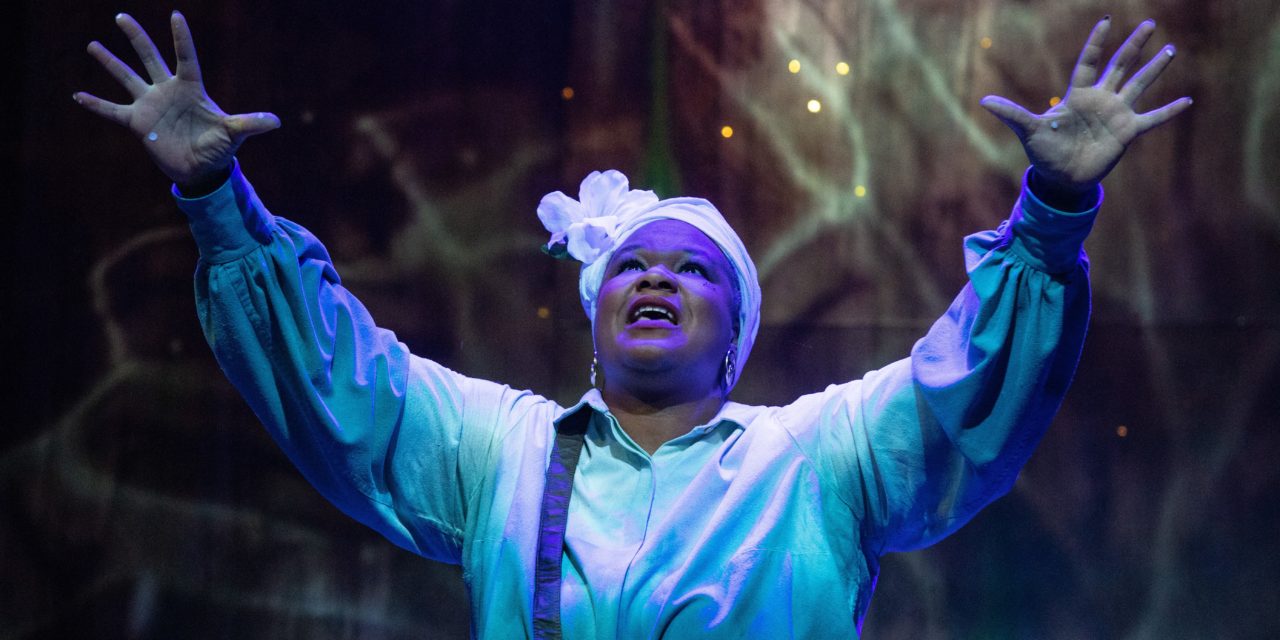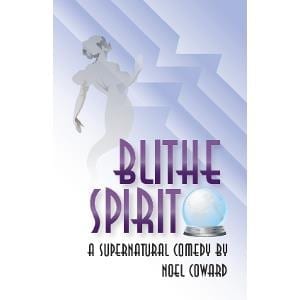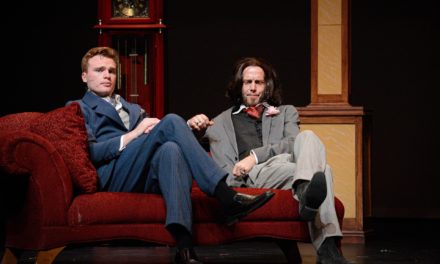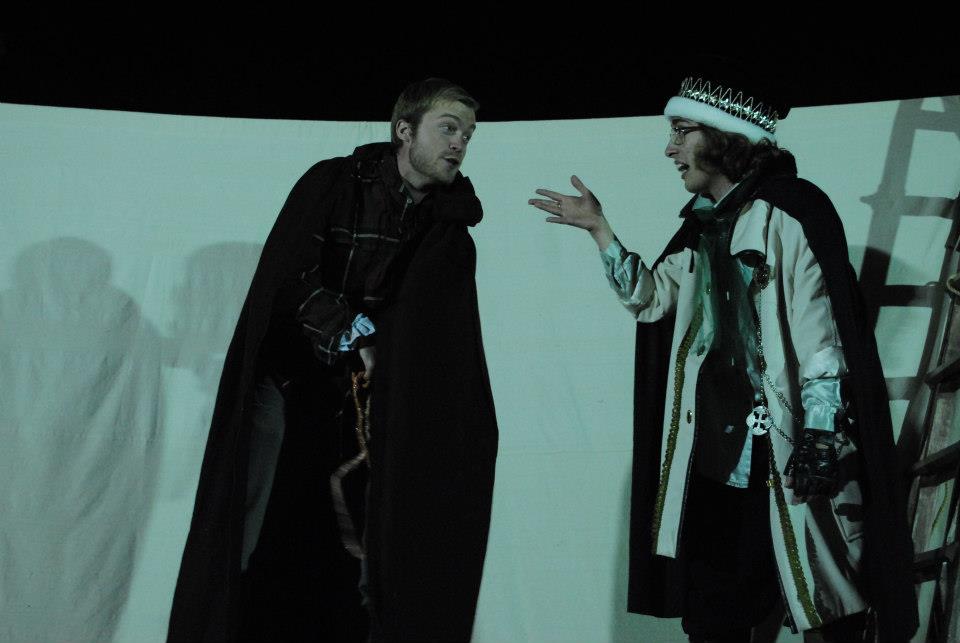CEDAR CITY — Shakespeare’s The Tempest tells a storm-tossed tale of shipwreck, new love, and letting grudges go. Utah Shakespeare Festival’s current production has much to admire, and some things that did not go down as smooth as an island piña colada.
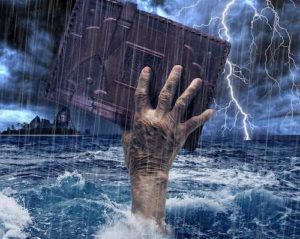
Show closes October 8, 2022.
As island wizard Prospero, Jasmine Bracey gave a magical performance. Her delivery was clear, natural and understandable as modern language—and she uncovered plenty of fun in the part while maintaining the role’s strength and dignity. One aspect of her performance that I had not seen in other productions was that Bracey made it obvious that Prospero really did like her daughter’s suitor, Ferdinand. But like any protective parent, she him wanted to prove his love.
Freedom Martin and Amara Webb were a strong dyad as young lovers Ferdinand and Miranda, respectively. Not only did they have the looks and delivery, they had plenty of romantic as chemistry. Martin in particular had some brilliant moments interpreting the text that brought life and meaning out of the Bard’s language. And Sophia K. Metcalf was effervescent as island spirit Ariel. Metcalf’s light, limber performance was heavily inspired by dance with songs firmly rooted in 1990s alt-rock à la The Cranberries and Alanis Morissette.
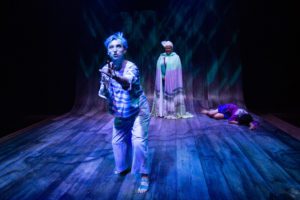
Left to right: Sophia K. Metcalf as Ariel, Jasmine Bracey as Prospero, and Amara Webb as Miranda in the Utah Shakespeare Festival’s 2022 production of The Tempest. (Photo by Karl Hugh. Copyright Utah Shakespeare Festival 2022.)
Cameron Knight’s direction made excellent use of the thrust stage, with perfect blocking and movement that gave everyone in the house a good view. I particularly enjoyed the use of the infinity wall as a slide when Alonso and Sebastian collapsed. This production was set in the 1990s, which was mostly window dressing except for one adorable moment when Ferdinand plopped his Walkman headphones on Miranda when a sensual Boyz II Men song came on, resulting in the biggest laugh from the audience of the show. The simple, smart, lovely set by Yee Eun Nam used an infinity wall to turn the entire stage and backdrop into one continuous tree. The stage was also surrounded by “sand,” evoking an island feel. After feeling sympathetic pain for the sandal-clad actors, I was relieved to find upon leaving the theater that it was actually soft, pulverized cork.
Costumes by Raquel Adorno had hits and misses. Stephano sported a Nirvana t-shirt, the costume design’s most obvious ’90s reference. Miranda’s brightly hued top and shorts had a delightful island vibe. The way Ferdinand’s costume degraded as he slaved away on the island was smart. And power-hungry villain Atonio’s green get-up was a nice mix of 16th century Italy and a modern power suit. One costuming fail was Antonio’s sunglasses. While they did seem like something that could have been worn off the coast of Italy circa 1995, they had the ghastly effect of obscuring the facial expressions of René Thorton, Jr., who was marvelous in Ragtime and Pericles last season. It is a shame when costume gets in the way of performance.
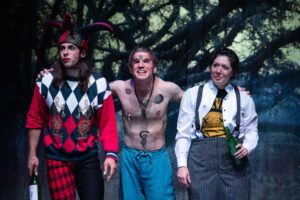
Left to right: Kevin Kantor as Trinculo, Aidan O’Reilly as Caliban, and Anatasha Blakely as Stephano in the Utah Shakespeare Festival’s 2022 production of The Tempest. (Photo by Karl Hugh. Copyright Utah Shakespeare Festival 2022.)
Yee’s set design included heavy, if not overwhelming use, of projection. It was super effective during exposition in Act I as Prospero introduced the characters and central plot. Together with sound designer Lindsay Jones’s thunderclaps and lighting designer Jaymi Lee Smith’s lightning flashes, those moments effectively educated the modern audience in an entertaining way. The way the projection washed over the stage like the sea during intermission was also mesmerizing. However in the second half, the production seemed to rely on projections to the point of laziness. For example, showing a blatantly obvious stock video clip of a dinner felt strange and out of place. And it was odd to see actors reacting to projected lights as if they were forest spirits, when other spirits, like Ariel, were personified onstage. While The Tempest may have had more technical bells and whistles compared to Cymbeline on the same stage last year, it felt less satisfying. The ’90s alt-rock music was also overbearing at points, particularly in the opening.
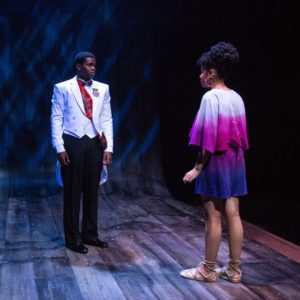
Freedom Martin as Ferdinand, and Amara Webb as Miranda in the Utah Shakespeare Festival’s 2022 production of The Tempest. (Photo by Karl Hugh. Copyright Utah Shakespeare Festival 2022.)
The theater suffered a power outage in Act III, which seemed to be caused by the intense special effects. The actors had to freeze onstage mid-scene. “Guess my magic was too good,” quipped Metcalf. After an announcement and a couple awkward minutes, the actors walked off stage. The issue was resolved and the performance continued after a 5-minute delay.
From my seat, it was not possible to enjoy the first 30 minutes of the production on account of not one but two children playing games on phones in plain view at full levels of brightness in the row in front of me. Due to the extreme darkness of the theater and thrust-style seating, I’m certain many in the theater were similarly distracted. “Surely USF, a professional theater, will put a stop to this,” I thought. They did, although not after an entire act had gone by.
Another thing holding the production back was that the comedic trio of Stephano, Trinculo, and Caliban was not very funny. As Stephano, Anatasha Blakely in particular seemed to struggle to get laughs. For a festival which has historically found comedic gold in unlikely places (their 2019 production of Hamlet was a laugh riot), it was disappointing to see a comedic character fail to connect. Kevin Kantor was more successful as the lanky jester Trinculo, decked out in red-and-black-checkered trousers and a silver chain, like a person who had stepped out of a London club in the ’90s.
Caliban was portrayed by Aidan O’Reilly, a great Shakespearean actor who wowed as Richard III last year and was plenty entertaining in The Comedy of Errors. His and the directors’ approach to the character is understandable, but unfortunate: O’Reilly played Caliban with all the gravitas of the hunchback king, even using a similar delivery. The result was a character so big and so dark that it did not seem to fit the production.
The Tempest included many of the high levels of production and acting that is expected in a Tony-award winning, Equity festival, including excellent acting by its protagonist and several supporting actors. However, this production did not reach the high bar the festival had set in the past and was more of a light snack than a satisfying meal.

This review is generously supported by a grant from the Utah Division of Arts and Museums.

